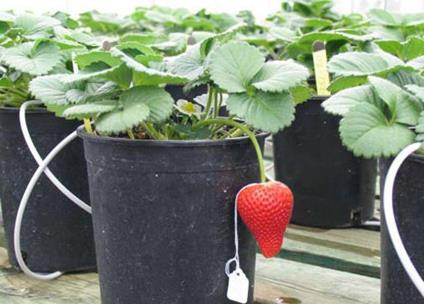Strawberry Breeding Program Backgrounder: Frequently Asked Questions
These strawberry plants are part of the research collection of some 1,700 strawberry plants managed by the UC Davis Public Strawberry Breeding Program. (Courtesy photo/UC Davis)
The UC Davis Strawberry Breeding Program has been a huge success for California. During six decades, the program has developed more than 30 patented varieties, made strawberries a year-round crop in California, and boosted strawberry yield from just 6 tons per acre in the 1950s to 30 tons per acre today.
Thanks to the UC Davis program, California growers pay lower rates than others for our strawberries and get access to new varieties before growers elsewhere. Fees from licensing strawberry varieties go back to the program to support the research and innovation on which the industry relies.
UC Davis has an unwavering commitment to continue the public breeding program today and into the future. Below are answers to some of the most frequently asked questions about the program:
What is the UC Davis Strawberry Breeding Program?
The University of California has been breeding strawberries since the 1930s, and the Strawberry Breeding Program has been located at UC Davis since 1952. The program, including both research and teaching components, is housed in the UC Davis Department of Plant Sciences in the College of Agricultural and Environmental Sciences. Its goal is to develop new, commercially useful varieties of strawberry plants that have higher quality berries, are less vulnerable to pests and diseases and can be grown more efficiently. The program now provides education and training for graduate students and will soon expand to also include undergraduate students.
What is California's standing in the strawberry industry?
California is the dominant producer of both fresh and processed strawberries, providing more than 87 percent of the strawberries consumed in North America. Strawberry varieties developed at UC Davis produce about 60 percent of the strawberries consumed worldwide.
How many varieties have been developed by UC Davis strawberry breeders?
The university currently holds patents on more than 30 strawberry varieties, all of which have been licensed to nurseries to commercialize and sell to strawberry growers. For the first two years after patenting, varieties from the program are available only to nurseries in California, giving growers in the state a competitive advantage.
How is the breeding and research program funded?
The program is funded primarily by revenue from licensing strawberry varieties. The amount of licensing revenue varies from year to year but in fiscal year 2014 the University of California collected $6.4 million in gross licensing revenue on five of its patented strawberry varieties. After deduction of certain patent expenses, the remainder is shared between the campus inventors, the UC Office of the President and UC Davis, with some of the university funds going to support the program.
Will UC Davis be licensing the strawberry plant collection to any commercial breeders or other researchers?
The university has decided that the germplasm, or experimental collection of strawberry plants, will be retained strictly in the public breeding program, rather than being licensed to any commercial breeders or companies. The breeding program's patented and licensed strawberry varieties, however, will continue to be made available for a fee to nurseries, which sell the plants to strawberry farmers.
How does the breeding program benefit strawberry growers?
California farmers pay lower rates than other farmers for UC Davis-developed strawberries because of the strawberry breeding program. The university is committed to ensuring that our rates will remain highly competitive and attractive in the future. Our current licensing fee of 8 cents per each plant that the contracting nurseries sell to growers is considerably lower than those of other university or commercial breeding programs.
What steps has the university taken to ensure the ongoing stability and productivity of the strawberry breeding program?
The university has created multiple copies of each of the approximately 1,700 strawberry breeding plants in the germplasm collection -- and made additional copies of each of the plants. The UC Davis Strawberry Breeding program will continue to serve California's strawberry producers, shippers, processors and consumers, as it has done for more than 60 years.
Who currently runs the strawberry breeding program?
It is under the leadership of director Steve Knapp, a professor of plant sciences with extensive experience in both university and commercial breeding programs, and research supervisor Glenn Cole, an experienced plant breeder also of the Department of Plant Sciences.
Who owns the strawberry plants in the breeding program's germplasm collection?
The collection of strawberry breeding plants is the property of the University of California. All University of California employees sign a form at the time they are hired, agreeing that any inventions or discoveries that they make during their employment at the university belong to the university. University breeders do, however, get part of the royalties that the university receives on patented and licensed strawberry plant varieties, which the breeders have developed.
What are the current locations for the public breeding program?
The UC strawberry breeding program operates out of four primary locations: The UC Davis campus, Wolfskill Experimental Orchards in Winters, Watsonville, and the South Coast Research and Extension Center in Irvine.The strawberry germplasm, or breeding-plant, collection is maintained by clonal propagation at the Wolfskill location and storage at UC Davis, with backup propagation in UC Davis greenhouses. Besides ongoing breeding and genetics experiments at the aforementioned locations, the program conducts field trials with commercial growers across the state.
Media Contact
Pat Bailey, News and Media Relations, 530-752-9843, pjbailey@ucdavis.edu

